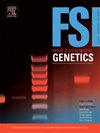一个健壮的跨组织DNA甲基化模型,用于口腔样本的法医年龄估计
IF 3.1
2区 医学
Q2 GENETICS & HEREDITY
引用次数: 0
摘要
基于DNA甲基化的实足年龄估计是一种强大的法医工具,但其应用于常见的口腔来源样本(例如,口腔拭子,唾液)受到组织特异性和固有细胞异质性的阻碍,通常导致现有模型的预测不准确。本研究旨在通过开发和验证一个强大的跨组织DNA甲基化模型来克服这些局限性,用于从这些样本中估计法医年龄。我们量化了216对口腔拭子和唾液样本(2-83岁的汉族)中18个CpG位点的DNA甲基化,并系统地评估了32种模型配置——不同的CpG标记面板、年龄转换和组织变量包含——以确定具有高跨组织稳定性和优化预测准确性的标记。优化的10-CpG分位数回归模型在10倍交叉验证中实现了3.19年(口腔拭子)、3.44年(唾液)和3.45年(组合数据集)的平均绝对误差(MAEs)。至关重要的是,该模型在法医相关口香糖样本的独立验证集上表现出优异的性能(n = 25,年龄19-70岁;MAE = 3.29年)。该模型在亚硫酸氢盐转化的DNA输入低至5 ng时也保持了可靠的性能,并且在不受控制的环境储存31天后保持稳定。我们的研究结果为不同口腔样本的法医年龄估计建立了一种方法学上合理且实际有效的跨组织方法,为现实世界案例中组织变异性和细胞异质性的挑战提供了可靠的解决方案。本文章由计算机程序翻译,如有差异,请以英文原文为准。
A robust cross-tissue DNA methylation model for forensic age estimation from oral samples
DNA methylation-based chronological age estimation is a powerful forensic tool, but its application to commonly encountered oral-derived samples (e.g., buccal swabs, saliva) is hampered by tissue specificity and inherent cellular heterogeneity, often leading to inaccurate predictions with existing models. This study aimed to overcome these limitations by developing and validating a robust cross-tissue DNA methylation model for forensic age estimation from such samples. We quantified DNA methylation at 18 CpG sites in 216 paired buccal swab and saliva samples (Han Chinese, 2–83 years) and systematically evaluated 32 model configurations—varying CpG marker panels, age transformation, and tissue variable inclusion—to identify markers with high cross-tissue stability and optimize predictive accuracy. An optimized 10-CpG quantile regression model achieved mean absolute errors (MAEs) of 3.19 years (buccal swabs), 3.44 years (saliva), and 3.45 years (combined dataset) in 10-fold cross-validation. Crucially, this model demonstrated excellent performance on an independent validation set of forensically relevant chewed gum samples (n = 25, aged 19–70 years; MAE = 3.29 years). The model also maintained reliable performance with bisulfite-converted DNA inputs as low as 5 ng and remained stable after 31 days of uncontrolled environmental storage. Our findings establish a methodologically sound and practically validated cross-tissue approach for forensic age estimation from diverse oral samples, offering a reliable solution to the challenges of tissue variability and cellular heterogeneity in real-world casework.
求助全文
通过发布文献求助,成功后即可免费获取论文全文。
去求助
来源期刊
CiteScore
7.50
自引率
32.30%
发文量
132
审稿时长
11.3 weeks
期刊介绍:
Forensic Science International: Genetics is the premier journal in the field of Forensic Genetics. This branch of Forensic Science can be defined as the application of genetics to human and non-human material (in the sense of a science with the purpose of studying inherited characteristics for the analysis of inter- and intra-specific variations in populations) for the resolution of legal conflicts.
The scope of the journal includes:
Forensic applications of human polymorphism.
Testing of paternity and other family relationships, immigration cases, typing of biological stains and tissues from criminal casework, identification of human remains by DNA testing methodologies.
Description of human polymorphisms of forensic interest, with special interest in DNA polymorphisms.
Autosomal DNA polymorphisms, mini- and microsatellites (or short tandem repeats, STRs), single nucleotide polymorphisms (SNPs), X and Y chromosome polymorphisms, mtDNA polymorphisms, and any other type of DNA variation with potential forensic applications.
Non-human DNA polymorphisms for crime scene investigation.
Population genetics of human polymorphisms of forensic interest.
Population data, especially from DNA polymorphisms of interest for the solution of forensic problems.
DNA typing methodologies and strategies.
Biostatistical methods in forensic genetics.
Evaluation of DNA evidence in forensic problems (such as paternity or immigration cases, criminal casework, identification), classical and new statistical approaches.
Standards in forensic genetics.
Recommendations of regulatory bodies concerning methods, markers, interpretation or strategies or proposals for procedural or technical standards.
Quality control.
Quality control and quality assurance strategies, proficiency testing for DNA typing methodologies.
Criminal DNA databases.
Technical, legal and statistical issues.
General ethical and legal issues related to forensic genetics.

 求助内容:
求助内容: 应助结果提醒方式:
应助结果提醒方式:


